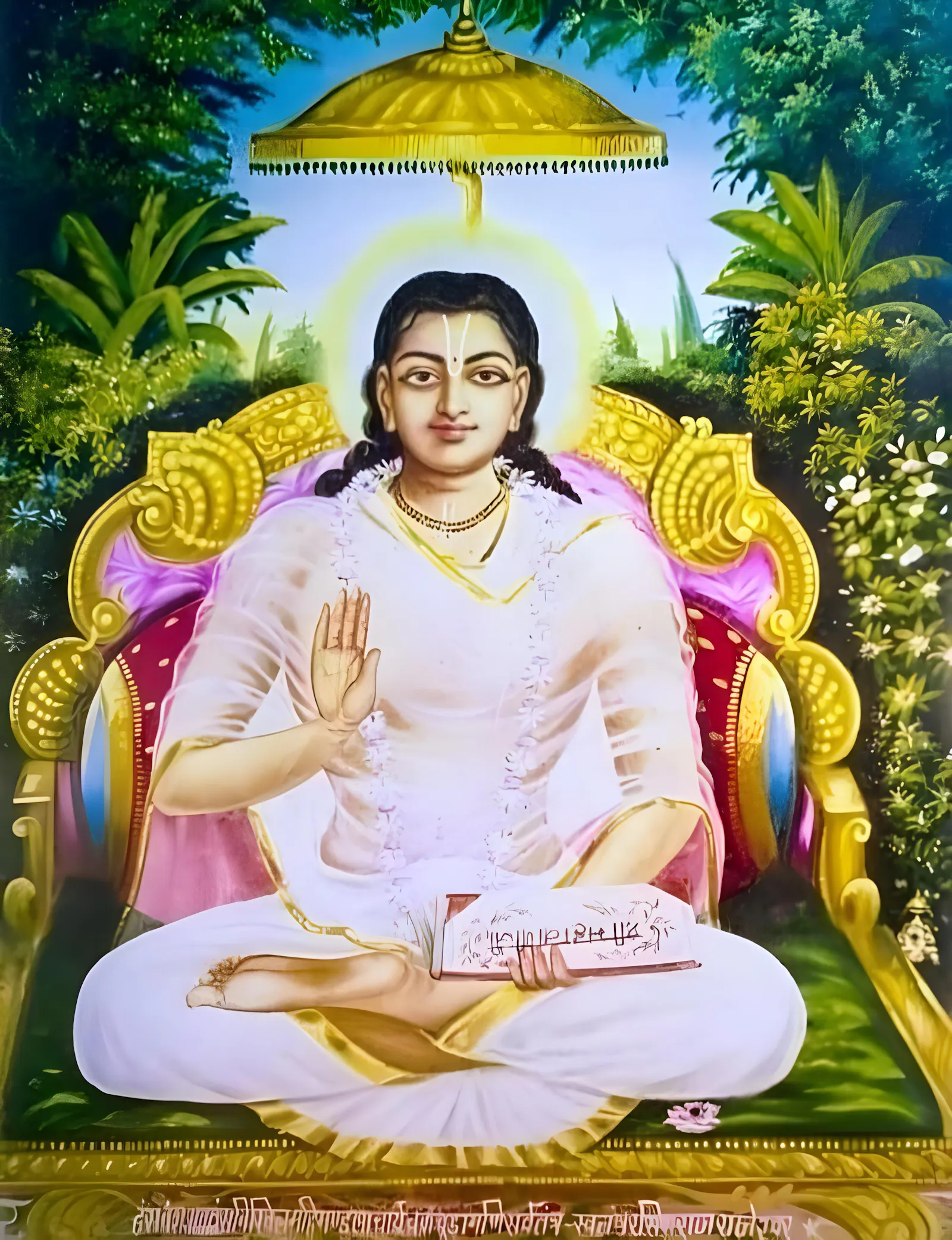Mahāvāṇī, verse 55-56
Mahāvāṇī is a revered poetic and theological composition in Braj Bhāṣā, written in the 15th century by Śrī Harivyāsa Devācārya, a key figure of the Nimbārka Sampradāya. It is considered one of the foundational devotional works of the tradition, deeply rooted in rasika-bhakti—the intimate and ecstatic worship of the divine couple Rādhā and Kṛṣṇa.

Mahavani, verse no 55
Nirakhi nirakhi Sri Hari priya, ang sangini saheli
Laad laadili karat mili, rahasi kunj mein keli.
Laad laadili keli nikunje.1
Kamal kamal kreeda krit kausal, rahasi vihasi ras keli nikunje.2
Paras saras marsani urjani, kar karsat karjani keli nikunje.3
Ang sangini sahachari Sri Hari priya harakhi nirakhi sukh keli nikunje.4
Mahavani, verse no 56
En men sukh sen dou, moorati mradul bihaar
Karat rahou nisidin bipin, chin chin hu balihaar
Yaa baanik par hu balihaari.1
Bipin bihaar karat rahou nisidin, chin chin prati par hu balihaari.2
En men sukh sen sakhin ke, chen den par hu balihaari.3
Sri Hari priya manoj manohar, mradu moorati par hu balihaari.4
Translation by Pratibha Goswami
Verse no 55
Priya Priyatam are enjoying the secret ras keli together in the nikunj. Witnessing this ras keli, Sri Hari Priya sakhi and the other sakhis are very pleased.
Laadili Laal are enjoying Their divine keli in the nikunj.1
They are playing with lotus. Observing Krishna's skills during the secret keli, Radhey ju is laughing.2
Krishna is sometimes touching, squeezing or massaging the lotus filled with pollen. Radhey ju resists, yet he tries to touch the lotus again and again.3
Beholding this beautiful ras keli within the nikunj, Sri Hari Priya Sakhi, along with the other sakhis, is filled with joy.4
Verse no 56
Both Priya Priyatam are the abode of all divine amorous pleasure. They are enjoying vipin bihaar every moment. The Sakhi offers her life to see this beautiful divine keli.
The sakhi offers her life to see this beautiful keli.1
She is blessings Them and saying, »Both of you are engrossed in this divine keli day and night, each moment. I offer myself for your enjoyment.«2
The sakhis are offering their own pleasure, joy and comfort to this divine couple.3
Sri Hari priya sakhi says, »You are the embodiment of Rati and Kaamdev. I offer myself to this soft-hearted, beautiful couple.«4
📘 Mahāvāṇī by Śrī Harivyāsa Devācārya – Background and Overview

👤 About the Author
Śrī Harivyāsa Devācārya (1443–1543) was the 35th ācārya in the disciplic succession of the Nimbārka Sampradāya. He was a disciple of Śrī Śrībhaṭṭa Devācārya. He significantly expanded the influence of the tradition by initiating twelve principal disciples who each founded their own lineages. His samādhi (tomb-shrine) is located in Mathurā at Nārada Tīlā.
📖 Structure and Content of Mahāvāṇī
The Mahāvāṇī is divided into five chapters (sukha) that each explore a distinct aspect of divine love and devotional service:
Sevā-sukha (128 padas):
Describes the daily aṣṭayāma-sevā (eightfold daily service) to Rādhā and Kṛṣṇa, in which the devotee meditatively assumes the role of a sakhī (female companion) serving the divine lovers.Utsāha-sukha (189 padas):
Glorifies the various joyful festivals and celebratory moments in the lives of Rādhā and Kṛṣṇa.Surata-sukha (106 padas):
Focuses on the intimate amorous pastimes (surata-līlā) of the divine couple, emphasizing their deep mutual affection.Sahaja-sukha (107 padas):
Reflects on the natural emotions experienced in divine love, such as fear of separation, longing, and spontaneous ecstasies.Siddhānta-sukha (44 padas):
Presents the philosophical conclusions (siddhānta) of the Nimbārka tradition, covering topics such as upāsya-tattva (the nature of the worshipable Lord), dhāma-tattva (the divine abode), and the sakhī-nāmāvalī (names of Rādhā’s eternal companions).
🌺 Theological Significance
A core teaching of the Mahāvāṇī is the non-difference between Rādhā and Kṛṣṇa, expressed in verses like:
“rādhāṁ kṛṣṇasvarūpāṁ vai, kṛṣṇaṁ rādhāsvarūpiṇam”
“Rādhā is the very form of Kṛṣṇa, and Kṛṣṇa is the very form of Rādhā.”
This line highlights the oneness in duality of the divine couple, a central doctrine of the Nimbārka Sampradāya. The Mahāvāṇī serves both as an emotional outpouring of divine love and as a manual for meditative devotional practice.
📚 Availability
Find here the translation of the introduction by Pratibha Goswami.
The original Mahāvāṇī is available online through the Internet Archive:
A version of the Sevā-sukha section, including the Rasika Bodhinī Ṭīkā (commentary) by Prem Nārāyaṇa Śrīvāstav, is also accessible:
🎧 Video Resources
A musical recitation of the Mahāvāṇī is available on YouTube:
https://www.youtube.com/watch?v=8TNzIgGYm5Q (Opens in a new window)

